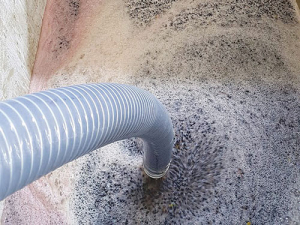“Ah, j’adore cette odeur,” says Charly, one of Villa Maria’s French cellar hands for the 2018 vintage.
Charly hails from Givry in Burgundy and while the verb ‘adorer’ is used a lot in the French language (much to my Calvinist grandmother’s chagrin: “on a adore que Dieu,” she would say - one can only ‘adore’ God), he could be talking about anything from a Christian Dior perfume to a ripe Epoisses.
In fact, he’s talking about the waft coming from one of Esk Valley’s 13 concrete four-ton fermenters, freshly installed in the new Villa Maria winery in Hawke’s Bay. They were put in at the request of Esk winemaker Gordon Russell, who says their presence in a world of stainless steel shows “incredible commitment” from founder Sir George Fistonich, who, he says, saw the considerable investment from the perspective of Esk’s unique wine style and brand.
Esk’s original concrete fermenters - of which there are 23, built, with the winery, in the mid-1930s - have been so long a part of the Esk story that they have an almost legendary quality.
“Five-ton concrete tubs, set into the earth,” as Russell describes them. “It took many years to learn but different fermenters had different properties.”
He likes the randomness of the temperature control: “you sacrifice a bit of precision”, but in his 28 years at Esk, he had more or less worked it out. The Terraces, Esk’s flagship wine, for instance, always had fermenter Number 2 reserved for its fruit.
Andy Lebioda, Assistant Winemaker at Villa Maria, tried to continue the tradition this vintage but unfortunately the fruit this year ended up in number 12.
Another tradition transferred from Esk is that of plunging, which is always done by four people. This made for a fast, less demanding process.
It brings ‘a social aspect to a demoralising job’, adds Russell. But in winemaking terms, he says it gave a thorough and gentle extraction. “We’ve always made Bordeaux wines as a Pinot Noir producer makes theirs,” he says.
“There’s a distinctive style to Esk reds and concrete plays a part in that,’ he continues. ‘The wines are earthy - in a positive sense - generous and soft in nature. Concrete has made that style.”
The only way to find out if that style could be transferred to the new winery was to have concrete there. The 13 Nomblot fermenters, shipped over from France, are more sophisticated versions, says Russell, “they are things of beauty - amazing to look at”.
They were installed with a mobile platform in order to allow four people to plunge each tank and while the original fermenters at Esk are painted on the inside walls, these are raw concrete.”
Surely, though, the French do not have a monopoly on concrete box builders?
“To have them made in New Zealand would have entailed a trial and commission and so on. We wanted 13 fermenters at once and Nomblot are the world leaders,” he replies. “But there’s no reason at all why the tanks couldn’t be built here - I’d encourage other wineries to do so.”










